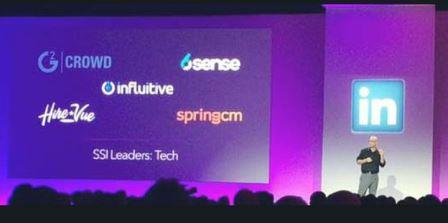I’m a believer in the power of relationships. That’s why when I attended LinkedIn Sales Connect forum last week in Las Vegas, my number one goal was to meet and learn from the best in the industry. Never in my wildest dreams did I think that I would be ranked in the top percentile of social sellers at the event, using LinkedIn’s new Social Selling Index, or that 6sense would be honored as one of the top-5 social-selling leaders in technology.
I was humbled and grateful to be personally recognized AND to be part of such an amazing team. After the event I decided I would take a moment to put pen to paper and outline some of the values and approaches I’ve used in my career to put meaningful relationships and long-term friendships first.
From the beginning of my career, I’ve thought that selling hast to be a grassroots effort: individuals reaching out to individuals to educate, consult, and help them achieve their goals as professionals and as people. To do this was to go directly against the product, feature and technology selling that are, even today, the common stock of the sales profession. Here are my 6 tenets of social selling:
1. Do Your Research
There is nothing more frustrating then having a conversation with someone who doesn’t understand you, your company and the challenges you’re facing. With LinkedIn Sales Navigator, there is no excuse for bland and generic outreach or scripted calls and meetings.
Before I do anything, I spend time trying to understand the company, the teams and the people I’m trying to connect with. You can organize searches by job titles, functions, companies, and many other demographic criteria to create a map of the company and then save the individuals relevant to your search.
Once you have a decent map of the organization you’re pursuing, begin reading the digital body language and looking for a commonality with the people you’ll need to win over. Looking at what people say about themselves and how they say it can let you know a lot about their personality and help you find that common denominator to jumpstart an honest and genuine conversation.
2. Find Your Champion And Don’t Send Them A Form Email
The spray-and-pray approach of sending bulk, standardized emails in the hopes of winning 1 out of 100 prospects guarantees only one thing: that you’ll alienate 99 of them. When I look at an organization, even if I’ve built a company map of 20 people, I will only reach out to the 1 or 2 that I have a strong connection with first. I’m interested in those people who I believe will find my message helpful and be able to share it effectively within their organization.
To catch the attention of and start building a meaningful relationship with a champion, do not send a boilerplate email. You want the person to recognize you as a unique collaborator who can help them achieve their goals. You want your company to be a standout vendor. You can’t do that if you treat them like a name on a list. Make sure that your outreach is personalized and is focused on the shared experience you have with the individual as well as their goals and projects, not your features and products.
3. Create A Credible Brand
Your profile on LinkedIn and your presence online are as important as your company’s brand. Make sure that you convey the things that are important to you and to your prospects: how you deliver value for your clients, what you’ve accomplished with partners in your career and what motivates and drives you. Each section is an opportunity to share a connection with your network, don’t miss it!
4. Use And Build Your Network
I can’t overstate how much I rely on my network, both on LinkedIn and offline. I use primary and secondary connections to get introductions, learn about the people I’m reaching out to and to get around obstacles when a particular approach isn’t working.
I try to make sure to connect with everyone I meet and to be open about asking for introductions. In the same breath I am always generous with my network and am happy to help connect people. I’ve found that whatever I give comes back to me tenfold, especially when a connection I make helps people achieve their goals.
5. Face Time
I attend a lot of events. There is no substitute for meeting people in person. If you want an opportunity to really move a conversation forward, reach an individual you haven’t been able to connect with online or talk through an obstacle, nothing beats seeing someone face to face.
Speaking engagements are where professionals promote their companies and expertise, but as often as not, they’re also places where professionals are subtly signaling about the business challenges they’re working on and trying to overcome. If you listen carefully, offline events are the best places to discover accounts that are a great fit for the value your company delivers.
6. Put Relationships First
Sales, like a lot of life, is all about timing. Meaningful, value-based relationships won’t always end in a sale in the short-term, but they are the best way to make sure that you are top-of-mind when the time is right. Always put the relationship ahead of the sale, stay diligent in your follow-up and continue to provide value and educate your prospects. And sure enough, when the timing is right, you’ll be ahead of your competition.
If your goal is to educate and help, to deliver value and expertise, then the sale will become a natural and organic part of your work. It won’t happen overnight and it won’t work every time, but it will build a network of relationships and connections that are the true value of any sales professional worth their salt.
Digital & Social Articles on Business 2 Community(123)
Report Post




